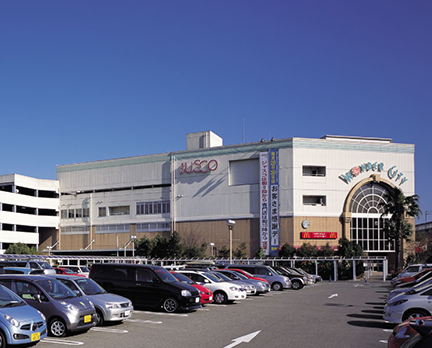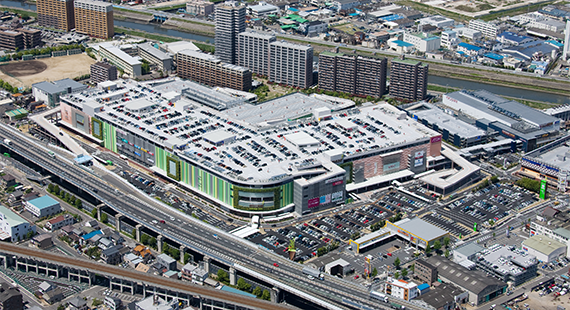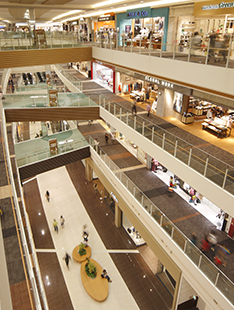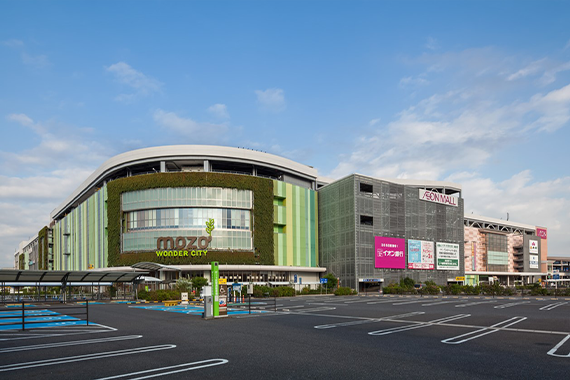Growing with Our Assets –
KJRM’s Strength in Management
Although located in a regional city, the commercial facility mozo Wonder City attracts approximately 15 million visitors annually. Through continuous renewals, tenant relationship building, and efforts in digital transformation, we have engaged with this property over the long term and grown together with it. The lessons from this success have been carried over to other properties, driving further evolution of our operational capabilities.
CHAPTER 01Redesigning how People Gather
mozo Wonder City, located in Nagoya, traces our involvement back to 2005. At the time, it was known simply as “Wonder City,” consisting of twelve buildings centered on the main Wonder City building, completed in 1994, and the Wonder Square building, completed in 1972. The site also contained a former housing exhibition ground with a site area of approximately 33,000 m².


From the time of acquisition, we considered value-up plans utilizing idle land and advanced basic building and branding plans, believing that comprehensive redevelopment would maximize the property’s potential.
However, due to legislation enacted after acquisition—something unforeseen at the time—we determined that entrusting redevelopment to a developer was the best course. In 2007, we transferred the property to our then-parent company Mitsubishi Corporation, which undertook redevelopment. In 2009, the facility was reborn as mozo Wonder City.
CHAPTER 02 Efforts to maintain freshness
Japan Retail Fund Investment Corporation (JRF, the former name of JMF) reacquired the property in four phases between 2011 and 2015.
The redevelopment had greatly expanded the property: sales floor area was about 2.7 times larger, reaching approximately 130,000 m²; tenant numbers had grown from 25 to around 220; and parking capacity increased by 2.1 times to about 5,000 vehicles.



Our role, however, did not end with reacquisition.
Post-acquisition, the focus shifted to exercising our operational capabilities: closely monitoring the competitive environment and changing customer needs, continually planning renewals to maintain the facility’s freshness and value, and thereby steadily enhancing recognition, drawing power, and reputation.
Recognition of these efforts came in the form of the Fighting Spirit Award at Senken Shimbun’s Developer Awards Chosen by Tenants, where we have since become a regular presence.
More importantly, we felt a true transformation when tenants who once declined to consider us began to say, “We want to open here because it’s mozo.” The facility had grown from simply being a shopping center into a destination of choice.
CHAPTER 03:Riding the Trend and Building a Data Platform
— "What is needed to further strengthen operational capabilities in the fall of 2017?"
As we continued to think about this in our day-to-day operations, the idea of introducing an app to the facility came up. At the time, shop cards and point cards were still the norm, and while there was a trend for individual tenants to introduce their own apps, it was still rare for an entire facility to have an app. Sensitive to the changing times, we began to consider this. This was a digital world that was unknown to us until then. It wasn't just about the technology, but also about how to measure the value of digital information and determine the return on investment. We held numerous discussions and considerations in collaboration with many stakeholders, including vendors, property management companies, sales promotion companies, and tenants.
In 2019, the mozo app was launched, marking the acceleration of our digital transformation.

The app enabled us to collect diverse data, and this success was shared with other properties, increasing the number of facilities adopting apps. In addition, data such as sales figures (originally collected at each property) and, in some cases, foot traffic and customer flow data, which had long been accumulated but managed separately by property, could now be integrated. The app provided the opportunity to build a Customer Data Platform (CDP) that aggregated data across the portfolio. This allowed advanced analysis and utilization, significantly enhancing both operational analysis and management capabilities. As a result, we achieved sales growth and cost reduction through operational efficiency, contributing to improved profitability for the fund.
We possess a unique strength in combining extensive data utilization with operational know-how honed in the field over many years. Even in an era of rapid change, we meet challenges with solid analytical ability and flexible thinking, collaborating with tenants to drive greater customer attraction and sales. Such an asset management company is rare.
The name "mozo" comes from the sound that is made when something starts to move, the stirrings of life.
The facilities there will coexist with the local community, attract people, and grow.
We too will continue to grow, never fearing change, while sensing the stirrings of new value.
